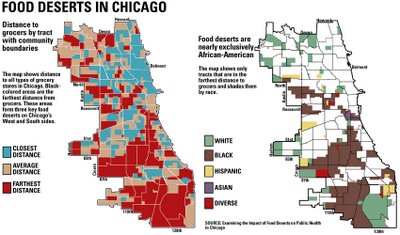 Researcher Mari Gallagher measured the distance to the nearest grocery and the nearest fast-food restaurant for every city block to come up with what she called a "food balance" score for each community area in Chicago. Image Credit: Chicago Sun-Times
Researcher Mari Gallagher measured the distance to the nearest grocery and the nearest fast-food restaurant for every city block to come up with what she called a "food balance" score for each community area in Chicago. Image Credit: Chicago Sun-TimesA report titled, "Examining the Impact of Food Deserts on Public Health in Chicago," is believed to be the first to examine the correlation between population and the access to food in supermarkets. Further, this report follows past research by Gallagher looking at the distribution of chain supermarkets in Chicago and access to grocery stores as a function of income.
Excerpts from the Chicago Sun-Times via FMI Daily Lead -
Early deaths tied to lack of grocery stores
BY JANET RAUSA FULLER Staff Reporter - July 18, 2006
Chicagoans who live in areas with scant grocery stores and many fast-food restaurants are more likely to die prematurely and at greater rates from diabetes, cancer or heart disease, a study to be released today finds.
Residents of such "food deserts" -- clustered predominantly on the West and South sides -- also are more likely to be obese and suffer from hypertension, according to the study commissioned by LaSalle Bank.
----
Taking into account health data for those areas and holding race, income and education constant, Gallagher found that the more "out of balance" a community is in terms of food choices, the higher the prevalence of chronic health issues and diet-related deaths.
Diabetes rates more than double
African Americans, in particular, are "most disadvantaged when it comes to balanced food choices," her research found. They travel the farthest on average to any type of food store and tend to live in communities that make up three main clusters of food deserts in Chicago, according to the study.
The death rate from diabetes in the worst -- and predominantly black -- food deserts is more than twice that of other communities, the study found.
"I think the good news of this study is that it brings a new call to action for what can be done in these communities," Gallagher said. "We know that across the country, the black population generally has higher diet-related deaths and health disparities. Can you change somebody's genetics? Can you change somebody's eating preferences? Can you change somebody's income? Certainly there are some things along those lines that can be done . . . but the good news is you can probably even more easily locate a grocery store somewhere."
----
The areas with the highest concentrations of single mothers and children "is almost a one-on-one match" with areas designated as food deserts, the study found.
Obesity also said to be related
The study, which will be the focus of a forum today at the Palmer House Hilton, also makes a correlation between the location of grocery stores and body mass index, suggesting that, "as grocery store access decreases, obesity increases." The West and South sides have the highest obesity rates, while the North and Northwest sides have the lowest rates, the study found. Gallagher said the addition of even a single grocery store in an area where there are few to none could lower obesity rates.
Read All>>
Why Symblogogy? -- If you are not scanning, you are not living!
No comments:
Post a Comment